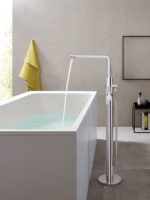Shopkeeper Maureen Doherty’s London apartment was designed to be versatile. A bathing room with a Japanese soaking tub is sometimes used for meetings, her front door holds a merchandise display case, and closing a row of builtin cabinets in the center of the main room transforms it from an open kitchen to a serenely neutral space.
Additional Content:
Jump to credits & specifications
“The flat might be used for photo shoots or to warehouse her clothing stock. Her brief was to have no names for rooms,” says Jonathan Tuckey, principal of London firm Jonathan Tuckey Design (JTD), which executed the idea. “Her boundaries between work and home are really blurred.”
The 1,100-square-foot apartment occupies spaces above and adjacent to Doherty’s boutique, Egg, in a house that was once a 19th-century dairy stable. Two years ago, Doherty commissioned JTD to renovate the building next door and convert its attic into a pied-à-terre. The new apartment would be a place where she could recharge her creativity and occasionally let the back-of-house functions for her business spill over.
Doherty and the design team agreed it was important to retain remnants of the building’s past life—exposed brick walls, a gabled roof, and a large triangular truss, which maintains its barnlike appearance. “We always strip everything back to how it was made. That helps us to uncover problems, but it’s also about aesthetics,” Tuckey says.
In addition to shooing away birds nesting in the rafters, digging to connect the old stables to the city’s service lines for gas and plumbing, reglazing skylights, and waterproofing and insulating the roof and walls, the architects highlighted the truss by painting it white to match the newly sheet-rocked ceiling and chimneylike baffles added around skylights.
Then came the work of making the space function in the open-ended ways that Doherty wanted. As kitchens are centers of home life, Tuckey first built in the flexibility there by installing a compact culinary center (an oven, counter, sink, refrigerator and pantry) within one of three boxy whitewashed volumes that sit like art installations in the space. The onewall kitchen also serves as a room divider that separates a living/dining area from a study and stairs down to the shop. When not in use, the kitchen disappears behind pocket doors. Another boxy partition houses a toilet with an adjacent shower and lavatory, while a traylike box that holds a sleeping loft is perched above in the rafters like a cozy nest.
JTD relied on humble materials to keep the overall costs down. The cabinets, a closet, and the sleeping loft’s walls are made from particleboard; door handles are pine. Kitchen and bath fittings are fashioned from unadorned copper pipes.
Elsewhere, luxury lies in the finishes. Paint covering the attic’s ceiling, walls, and floor is of high quality. The spare-looking bathing room is clad floor-to-ceiling in hand-glazed ceramic Portuguese tiles. Its Japanese-style soaking tub was custom-built in Sweden. The craftsmanship in these details is what Doherty wished to celebrate, just as she does with the artisanal dresses, perfumes, and housewares she carries in her shop. In that way, “it’s her very own chapel,” Tuckey says.
CreditsArchitect: Jonathan Tuckey Design
Project architect: Ryuta Hirayama
Engineers: Webb Yates
General contractor: Broseley
|
SpecificationsCustom cabinetry Broseley
Paint Farrow & Ball (walls, floor, ceiling)
Skylights Velux
Lighting Crompton Architectural Lamps (fixture in kitchen)
Sinks Aston Matthews
Oven Ikea
Showerhead Livinghouse |












